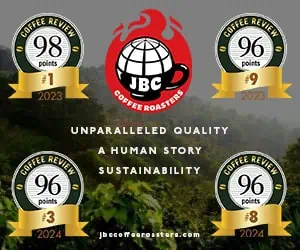The twelve coffees reviewed here represent a sort of best-of-category selection of coffees that have made their way to my table over the last couple of months. The four Hawaii coffees are new offerings from this past winter’s 1998/99 crop, as is the Jamaica Blue Mountain. The three blends are either new to everyone (The Roasterie’s Fifth Anniversary Blend) or new to me. The Allegro Yemen, the Barnie’s Ethiopia Yirgacheffe, and the Green Mountain Colombia have one quality in common: They are among the best of those origins I’ve tasted recently. I can’t say that the Counter Culture Coffee decaffeinated Peru is one of the better Perus I’ve cupped lately because I haven’t cupped many, but I do find it an impressive and characteristically Peruvian profile.
The three Konas describe a lovely trajectory of Kona cup, from the delicate, sweetly nuanced Honomalino peaberry through the sweet but balanced Honomalino Extra Fancy to the robust, powerfully acidy Armeno Extra Fancy. The more I work with Konas the more it becomes apparent that the broad generalizations we work with in regard to origin–Guatemalas taste this way, Sumatras that, etc.–are as much cultural fictions as they are botanical or gustatory realities. The Kona coffee industry, with its patchwork of small farms, many of them jealously guarding the integrity of their tiny productions, allows for comparing coffees from very limited and very distinct microclimates: from one side of a hill, for example, or from a particular pocket in a valley. And, although a medium-bodied, delicately nuanced, lightly acidy cup does seem to be the Kona norm, some Konas, like the Armeno Extra Fancy reviewed here, are mysteriously blessed by an abstract, almost monumental acidity that would make some high-grown Costa-Ricas look limp.
On the other hand, there is a great pleasure in suspending your nose over a cup and immediately recognizing the absolute essence of a certain set of familiar and agreeable sensations. The Ethiopia Yirgacheffe and the Yemen Mocha perfectly fulfill our expectations for these most distinctive of origins, while simultaneously exceeding them. The Barnie’s Ethiopia Yirgacheffe explodes with characteristic high-toned floral perfumes, yet adds a bit of heft or weight to the normally light-bodied Yirgacheffe profile. The Allegro Yemen Mocha is properly Yemen-like with its powerful, fruity acidity, fullish body, and quirky complexity, while managing to downplay the (to some) objectionably funky aftertaste of Yemens.
Turning to the blends, the three reviewed here accomplish what blends ought to: combine coffees that strengthen one another to create a broad but unified impression, rather than cancelling one another out to create a confused, opaque muddle, as is often the case with less successful blends. Two of the blends make tactful use of the sweet floral tones of Ethiopia Yirgacheffe at the top of the profile, filling in underneath with the dry richness of a traditional Sumatra in the case of the New World Mocha Java Style blend, and with unidentified but wonderfully range-stretching coffees in the Orleans Coffee Exchange Tchoupitoulas. On the other hand, the Roasterie Fifth Anniversary Blend aims at a lower-toned, horizontal richness rather than top-to-bottom range, and, to my palate, succeeds admirably.
The decaffeinated Peru from Counter Culture Coffee displays a characteristic that I think specialty coffee roasters often undervalue: the fragrantly sweet vanilla-nut complex of some softer-profile Latin-American coffees. Perhaps the unusual CO2 decaffeination process accentuated this characteristic, but, however it got there, I liked it.











